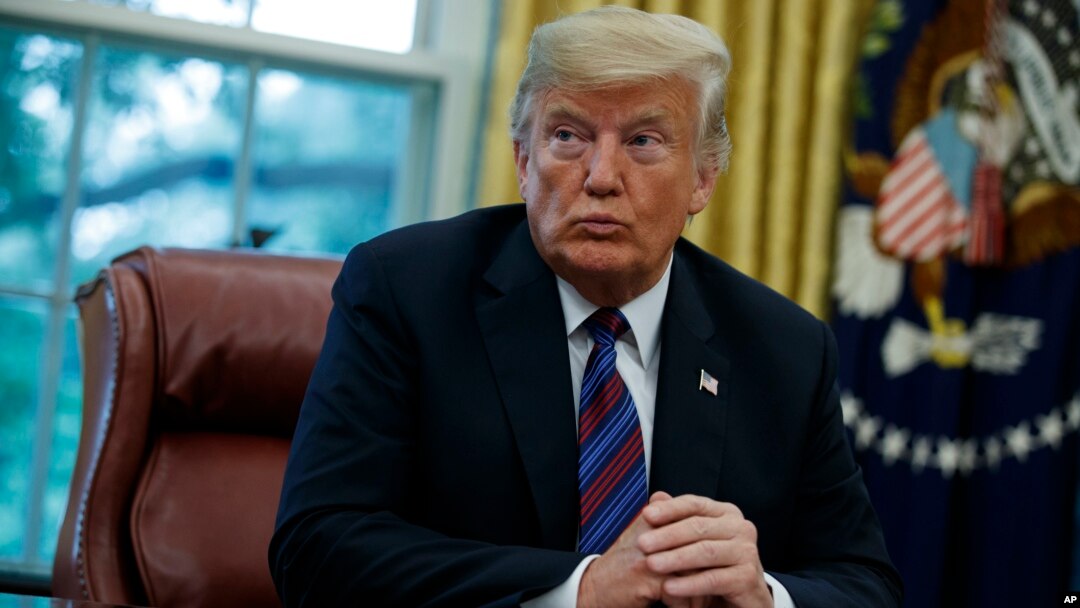The United States and Mexico have reached a trade agreement, leaving Canada as the odd man out in efforts to revise or replace the North American Free Trade Agreement (NAFTA), according to U.S. President Donald Trump.
The new deal will be called the United States-Mexico Trade Agreement, Trump said Monday.
“We’ll get rid of the name NAFTA, it has a bad connotation because the United States was hurt very badly by NAFTA for many years,” Trump said.
“It’s a big day for trade, it’s a big day for our country,” Trump said with reporters present, who were called to the Oval Office to watch as Trump spoke on the telephone with Mexican President Enrique Pena Nieto.

FILE - Mexico's President Enrique Pena Nieto gives a speech at the National Palace in Mexico City, Nov. 21 2017.
The Mexican leader expressed hope to “renew, modernize and update” NAFTA while Trump’s rhetoric indicated he sees that 24-year-old three-nation deal as dead.
“We’ll have a formal news conference in the not-too-distant future,” about the trade pact, Trump said to Pena Nieto.
“This is something very positive for the United States and Mexico,” Pena Nieto replied, saying he is looking forward to toasting Trump with tequila to celebrate, expressing to his American counterpart that he is “really grateful and greatly recognize and acknowledge your political will in all of this.”
Mexico has agreed to immediately begin purchasing as many agricultural products from the United States as possible, according to Trump.
Pena Nieto leaves office on December 1, turning over the Mexican government to his leftist successor, Andres Manuel Lopez Obrador. That means the clock is ticking to give Mexico’s legislature enough time to ratify it before the change of administration.
Congressional notification expected
The White House is also expected to formally notify Congress by the end of this week of its intention to sign a new trade agreement within 90 days.
“It will be likely be signed at the end of November,” said U.S. Trade Representative Robert Lighthizer, who was also in the Oval Office, along with Mexico’s foreign and trade ministers, for the Trump-Pena Nieto phone call.
The U.S. president, since the time of his 2016 election campaign has referred to NAFTA as the worst trade deal in history and repeated especially inflammatory rhetoric about America’s southern neighbor.
Trump, who blames NAFTA for the destruction of manufacturing jobs in the United States, repeatedly threatened to abandon the trade pact with Canada and Mexico, which came into effect during the Clinton administration in 1994.
"I'll be terminating the existing deal," Trump said Monday.
Trump has rejected other multi-national deals, such as the Trans-Pacific Partnership (another trade pact) and the Paris Agreement on climate change mitigation, expressing a strong preference for one-on-one negotiations on trade and other matters with countries.
FILE - President Donald Trump talks with Canadian Prime Minister Justin Trudeau during a G-7 Summit welcome ceremony.
Negotiations with Canada
Trump said the United States is open to talks with Canada if it is willing to negotiate fairly. He spoke by phone with Canadian Prime Minister Justin Trudeau, with the offices of both leaders releasing statements saying they discussed continuing U.S.-Canada negotiations.
Duncan Wood, director of the Wilson Center's Mexico Institute, told VOA at this stage a lot of work remains.
"We have resolution to the major issues that Mexico had with the United States and vice versa, but now that we throw Canada back into the mix I think it’s going to be a very interesting equation because Canada of course has a very different set of problems with the United States," Wood said.
In announcing the U.S.-Mexico deal, Trump also threatened Canada with penalties if there is no agreement with Trudeau's government.
“Frankly, a tariff on cars is the much easier way to go,” said Trump.
In Ottawa, officials are expressing resilience.
"We will only sign a new NAFTA that is good for Canada and good for the middle class,” said the Canadian foreign ministry in a statement, indicating Ottawa’s willingness to “continue to work toward a modernized NAFTA.”
“We hope that Canada can join in now,” Lighthizer subsequently told reporters during a conference call.
University of Ottawa public and international affairs associate professor Patrick Leblond told VOA it would make no sense for Canada to accept a new deal that is not to its benefit.
"Canada said, look, we have a deal now, we want to make it better, we want to modernize it, and we will only agree to a new NAFTA if we think it is a better deal overall and certainly a better deal for Canada. Otherwise, we’ll just keep what we have," Leblond said.
White House officials are denying that Monday’s announcement by the presidents of the United States and Mexico was designed to pressure the Canadians.
“Leaving Canada out of a new NAFTA would be a mistake and it is questionable whether the Office of the U.S. Trade Representative has the authority under current Trade Promotion Authority legislation to conclude just a bilateral with Mexico,” a visiting scholar at the Cato Institute, Inu Manak, who focuses on trade conflicts, tells VOA News. “What happens next is anyone’s guess, but we should keep our eyes open for the return of Canada’s Foreign Minister, Chrystia Freeland, to Washington to wrap up the discussions soon.”
The three North American countries do about $1 trillion in trade among themselves annually.


